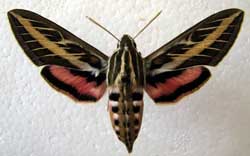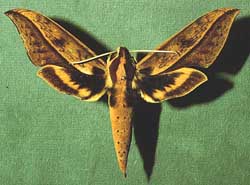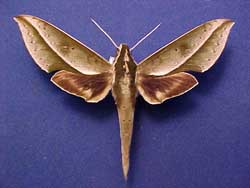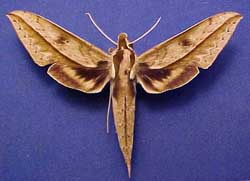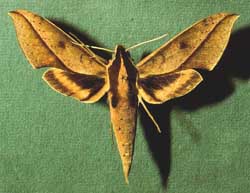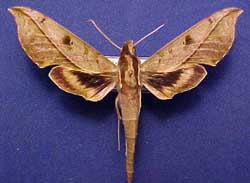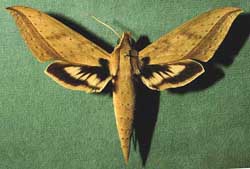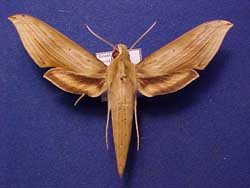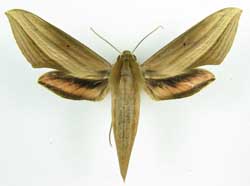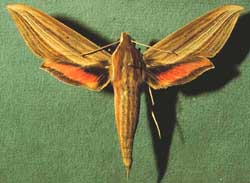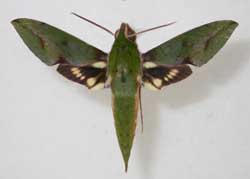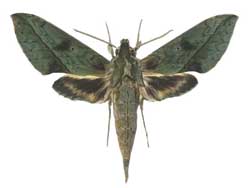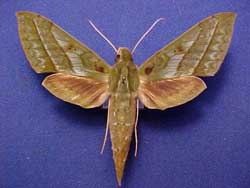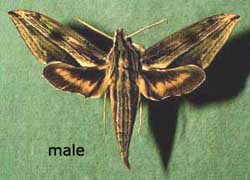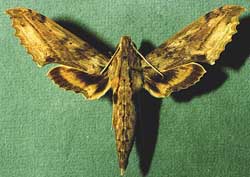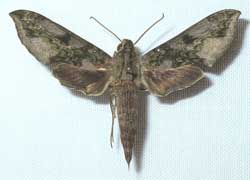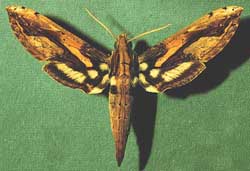
Xylophanes ceratomioides
Fw o.m. slightly scalloped.
Abdomen: three narrow, longitudinal lines; outer lines posteriorly divergent and expanded into triangular spots.
Costa: conspicuous subapical, apical black spots, largest subapical spot
triangular with inner point directed basally.
Median area running out to apex: pale brown with scattered black scales on veins; discal spot small,
black.
First four pm lines dissipate preapically before reaching costa, weak fifth line
runs to apex. First line slightly sinuate.
Second-fourth lines very scalloped near inner margin.
Oblique postmedian band dark with sinuate black lines within it, inner edge slightly undulate,
outer edge deeply excavate from CuA2 to just above M3,
forming a pale brown, oval patch; marginal area with black vein spots.
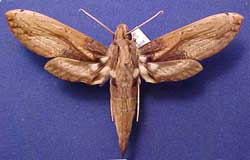
Xylophanes media
Similar to ceratomioides.
Fw o.m. less rounded below M2 than in ceratomioides; very slightly undulate.
Abdomen: three narrow lines; outer lines posteriorly divergent, not expanded into small triangular spots.
Fw elements more diffuse than in ceratomioides.
Costa lacking subapical, apical black spots.
Most distal antemedian line, most basal postmedian line meet on i. m. as in guianensis.
Pm band not clearly developed.
Hw subbasal, median bands: pale grey, shaded with brown, median band edges especially diffuse.
|
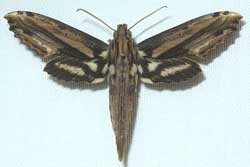
Xylophanes guianensis
Fw o. m. quite scalloped.
Outer abdominal lines not posteriorly divergent.
Fw costa: several conspicuous subapical and apical black spots, more proximate than ceratomioides,
the largest subapical spot quadrate.
Pm lines clearly visible within the postmedian area, almost straight, except toward inner edge of wing
(not scalloped as in ceratomioides)
Most distal antemedian line and most basal postmedian line meet on inner edge of forewing upperside;
; pale brown excavated area on outer margin of postmedian band narrow
(more so than in Xylophanes xylobotes), rectangular and not well defined due to the visible presence within it
of the third, fourth and fifth postmedian lines.
Pale bands of hindwing upperside intermediate in coloration between those of Xylophanes ceratomioides and Xylophanes xylobotes.
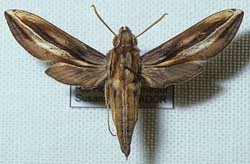
Xylophanes th. thyelia
Xylophanes thyelia has visible characters making it similar to members of the Xylophanes ceratomioides group, but it is a much smaller species.
The head has a dark longitudinal line, bordered ventrally with buff, above the antenna. The tegula have a dark brown median line, bordered on each side by a
pale grey stripe, irrorated with pale purple.
The abdomen has a brown midline, bordered by narrow grey lines; a brown lateral line present on segments 2-4, bordered ventrally by a pale buff line that
continues posteriorly to segment 7.
The forewing upperside is dark brown and buff. There is a short dark line present basal to the first postmedian line, reaching as far as the discal spot.
First, second and third postmedian lines arise almost from the wing base and are quite oblique. The first postmedian line reaches to just beyond M1;
the second postmedian line reaches Rs4; the third and fourth postmedian lines very narrow and close, sometimes fused for part of their length distally,
running from Rs4 to M3, below which they become a diffuse series of minute spots (continuous and distinct below M3 in Xylophanes thyelia salvini).
The area between the second and third postmedian lines, where they overlap, is conspicuously pale. The fifth postmedian line runs from the apex to M3 as a
gradually broadening triangular patch. There is an apical area bounded by the costa, fifth postmedian line and Rs4, and the tornal area bounded by M3, the
second postmedian line and CuA2, both pale brown and buff, with scattered individual black scales; Rs4, basal to second postmedian line, highlighted with
buff over distal half.
The forewing underside has three dark brown or black, parallel and equidistant postmedian lines.
The hindwing upperside is an almost uniform grey-brown. The median band is barely visible. in the male, the hindtibia have long scales dorsally and ventrally,
thus appearing very broad and compressed.
|
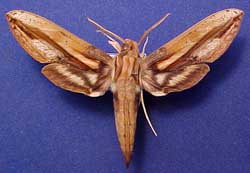
Xylophanes xylobotes
Fw o. m. not scalloped.
Outer abdominal lines not posteriorly divergent.
Fw costa: almost clear, more apical black spots almost non-existent.
Inner pm lines dissipate preapically well before reaching costa.
Generally much lighter appearance than ceratomioides or guianensis.
Much reduced buff basal patch.
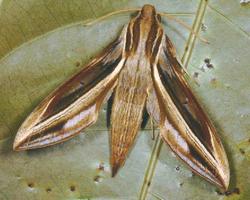
Xylophanes pyrrhus
CATE Sphingidae indicates this species is similar to Xylophanes thyelia thyelia. However, X. pyrrhus is much larger, and its forewing apex
is slightly more elongate and falcate. The forewing discal spot is smaller in pyrrhus, and the third and fourth postmedian lines are very narrow and
close, but never fused. These lines continue below M3 as a pair of more diffuse but essentially continuous lines. The fifth postmedian
line continues below M3 to the inner margin as a narrower and diffuse line. In thyelia this fifth line is very weak, almost non-existent in its lower half.
Rs4, basal to second postmedian line, is highlighted with buff over its entire length.
The forewing underside is also similar to that of Xylophanes thyelia thyelia, but the most basal of the three dark brown postmedian lines is further from the
middle line than that line is from the most distal line, and is slightly divergent from the other two apically.
I also find that the brown subterminal line in pyrrhus continues from the apex to the inner margin, broadening and becoming slightly more diffuse in its lower
half. The same line in thyelia disappears as it approaches the inner margin, providing for a relatively large, uniform tan area near the forewing anal angle.
|
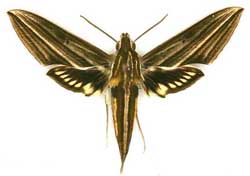
Xylophanes rhodotus ???
Intermediate between Xylophanes eumedon and Xylophanes titana.
"Tegula with a golden medial line (as in Xylophanes titana). Dorsal lines of upperside of abdomen similar to those of Xylophanes eumedon but pale lines broader
and less well defined, divided medially by an indistinct, thin olive-green line that become broader and more distinct towards the abdomen base; black basal and
yellow lateral abdominal patches less developed than in Xylophanes eumedon.
"Pattern of forewing upperside as in Xylophanes titana but much darker, so that the only conspicuous pale area is the space between the third and fourth postmedian
lines; discal spot larger than in Xylophanes eumedon and Xylophanes titana.
"Very similar to Xylophanes titana but paler.
"Hindwing upperside with pale yellow spots of median band sharply defined and distinct (as in Xylophanes aristor)."
|
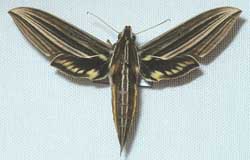
Xylophanes titana
|
|
|
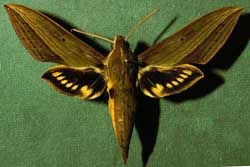
Xylophanes crotonis
Tegulae: no pale median line.
Fws, body: olive-green, fading to brown.
Each side of abdomen with basal yellowish-white lateral patch, extending onto metanotum, posterior of which is black patch and distinct yellow stripe.
dorsal lines vestigial or absent.
with a series of oblique lines running from the inner margin to the apex; first and fourth postmedian lines generally stronger than the second, third
and fifth, which are equal in intensity to the two submarginal lines. Hindwing upperside black; median band comprising a series of teardrop-shaped pale
yellow spots.
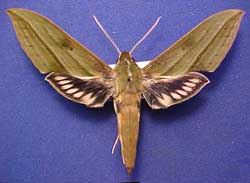
Xylophanes rhodochlora
Similar to Xylophanes crotonis but forewing smaller and distinctly shorter and broader, upperside brighter green and pattern simplified.
Thorax with grey dorsal stripe, similar to that of Xylophanes aristor. Tegula edged in white along its outer (lateral), but not inner
(dorsal), margin (the reverse pattern is found in Xylophanes vagliai); no median line of grey scales. Lateral tufts at posterior edge of
metanotum and base of abdomen bright yellow (yellowish-white in Xylophanes crotonis); yellow lateral stripe narrower, shorter and paler than in
Xylophanes crotonis, and speckled with orange and brown. Outer spur of midtibia equal to inner. Underside of thorax more orange than in Xylophanes crotonis.
Underside of abdomen more pink than in Xylophanes crotonis. Forewing upperside similar to Xylophanes crotonis but only first and fourth postmedian lines
conspicuous; first postmedian line straight; all other oblique lines vestigial or absent; discal spot larger. Marginal area of forewing underside dirty grey
with a scattering of black scales, very distinct from the brick-red ground colour of the rest of the wing and delineated by a grey line that is toothed on M2
(as in Xylophanes aristor).
|
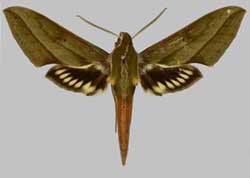
Xyloph. nabuchodonosor ???
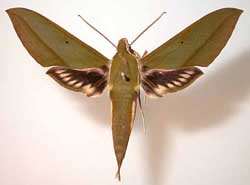
Xylophanes schwartzi
This species is similar to Xylophanes rhodochlora in the crotonis group, but schwartzi's carmine-red wing undersides from the fw discal cell outwards and the entire hindwing clearly distinguish it.
The reddish hue manifest itself elsewhere: the inner margin of the tegulae are edged with a very narrow pink line, the underside of palps, thorax and abdomen are pale pink, and there is a thin pink line running along the dorsal surface of the inner margin from the black tuft at the wing-body juncture to the midpoint of the inner margin.
On the olive-green forewing, only the khaki fourth post median line and the small black discal dot are distinct.
The hindwing spots in the median band have a powdering of green scales in their lower quarter. The hindwing outer margin is olive-green.
|
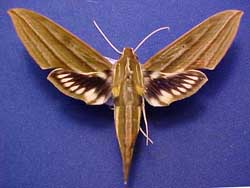
Xylophanes aristor
Xylophanes virescens
|
|
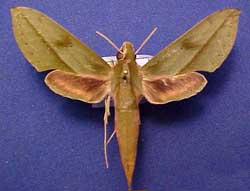
Xylophanes rothschildi
6.28 - 7.15 cm
Fw dark green with bluish tint; basally deeper olive-green.
Small concolourous oval patch runs longitudinally from
small, round, black discal spot to dark green oblique pml,
from mid i.m. to apex.
basal to this line
are two inconspicuous, narrow lines that recurve basad towards the costa; submarginal line represented by a row of small, black vein spots; fringe of
inner margin from base to postmedian line clearly pink. Hindwing upperside generally blackish with a diffuse and poorly defined pinkish-orange median band.
|
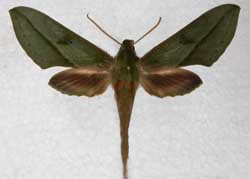
Xylophanes blanca ???
Fw g.c.: dull grey-green.
apex: slightly produced.
O. m.: slightly hollowed out below apex, then quite convex.
Cell spot: small black dot, then small slightly darker oval area.
Only straight 4rth pm line pronounced, slightly
preapical.
Other pmls vestigial.
Final line inwardly slightly scalloped, marked by distinct dark dots on veins.
I. m.: pinkish body to pml.
Hw: brownish-black, faint orangey-cream band, suffused w green above & below.
Narrow dark green o. m..
Fringes: greenish (concolorous);
darker intrusions along veins.
Extremely similar to rothschildi.
darker green oval patch distal to discal spot smaller.
Postmedian line narrower, arises beyond mid i.m..
|
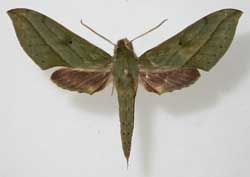
Xylophanes bilineata ???
Fw g.c.: dull grey-green.
apex: slightly produced.
O. m.: slightly hollowed out below apex, then quite convex.
Cell spot: large black dot, then small slightly darker area.
Straight 1rst & 4rth pmls;
4rth slightly preapical, most pronounced.
Internal pmls vestigial.
Final line: inwardly scaloped, marked with dark dots on veins.
Hw grey-black: a faint orangey-cream band; narrow dark green o. m..
Fringes: white; some dark intrusions along veins.
|
Very distinct species, unlikely to be confused with other species.
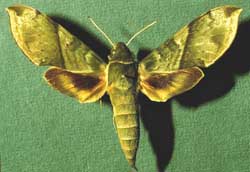
Xylophanes pistacina
Fw apex slightly produced, pointed.
O. m. hollowed out below apex,
evenly convex to anal angle.
G.c. variable: greenish-buff.
Three subparallel am lines, angled at
CUA1.
First two pm lines form broadly
preapical, prominent, straight, slightly oblique, dark band.
Third pml very faint.
Fourth pml distinct, vein dots.
Fifth pml curved from apex,
continuous with greenish olive patch from M2 to M3.
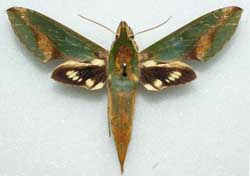
Xylophanes ch. nechus
Isla Gorgona, Cauca, June 5, 2011,
Humberto Calero Mejia
|
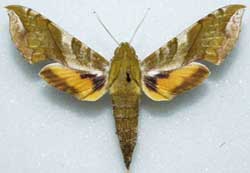
Xylophanes pluto
Tegulae: dark brown edges.
Fw apex slightly produced, pointed.
O. m. hollowed out below apex,
evenly convex, smooth or slightly crenulate, to anal angle.
Five subparallel am lines, evenly convex.
First pml thin but distinct,
slightly oblique, recurved toward body at costa.
Additional pmls very dentate, less distinct.
Prominent white subapical, basal-median suffusions.
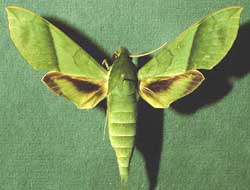
Xylophanes tyndarus
|
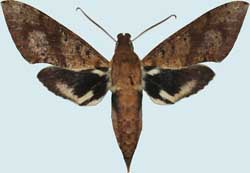
Xylophanes rufescens
G. c.: buff with scattered black spots, most concentrated on costa,
and rusty-brown spots and markings.
Am lines: incomplete bands of irregular black dots/blobs in convex arc
from below costa, terminating before i. m..
Rusty brown pm band is broadly preapical, subparallel to straight outer margin.
Broad rusty brown convex arc just outside cell,
semicirular rusty brown curve outside pml from M1 to CUA1.
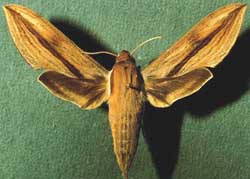
Xylophanes turbata
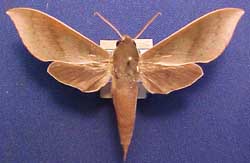
Xyloph. p. continentalis GN
|
|
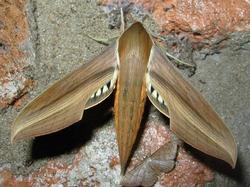
Xylophanes t. tersa
wingspan: 60-80mm
Tegulae: strong orange midline.
Abdomen: four strong pale brown lines
over orange g. c.,
weaker midline, outer lines.
strong orange lateral bands.
Fw o.m. slightly convex below hollowed out
subapical area.
1rst, 2nd pmls fused basally.
3rd, 4rth pmls thin over light background.
5-8th pmls thicker, but
weak basally.
Hw pale yellow spots generally elongating toward apex,
more basal closer to margin.
Thin orange suffusion above cream fringe.
|
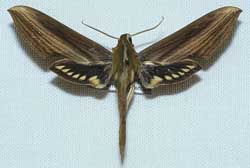
Xylophanes resta
forewing length: 36-41 mm.
Tegulae: weak golden midline.
Thorax: grey medial band, bordered laterally, divided medially by brown lines,
continuing along abdomen, becoming faint after first two abdominal segments.
Fw: characteristic brown tone,
First pml very strong basally, disappearing towards apex;
second pml fused basally with first;
fourth pml less than half width of first.
Hw pale yellow spots larger than tersa,
more distal closer to margin.
Xylophanes columbiana
Sorry, no image available,
similar to elara
|
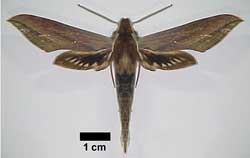
Xylophanes fernandezi
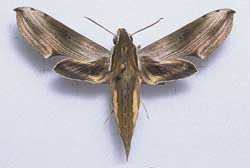
Xylophanes dolius
Wingspan: 70mm
Tegulae: distinct orange center stripe over dark brown
Abdomen: orangey-buff lateral bands;
midline segmented.
Apex slightly produced, pointed.
O.m. hollowed out below apex,
strongly convex to anal angle.
As many as eight grey brown pm lines, subparallel to
convex outer margin, accented over light grey ground colour.
Hw: diffuse off-white band,
further from o.m. near apex.
|
|
+++++++
Use your browser "Back" button to return to the previous page.
Visit Sphingini: Manduca
Visit Sphingini: Agrius, Amphimoea, Cocytius, Euryglottis, Lintneria, Sphinx
Visit Smerinthini: Adhemarius, Orecta and Protambulyx
Visit Dilophonotini: Aleuron, Enyo, Pachygonidia and Unzela
Visit Dilophonotini: Aellopos, Eupyrrhoglossum, Nyceryx and Perigonia
Visit Dilophonotini: Callionima, Erinnyis, Hemeroplanes, Isognathus, Madoryx, Oryba, Pachylia, Pachylioides, Phryxus
and Pseudosphinx
Visit Philampelini: Eumorpha
You are here: Macroglossini: Hyles and Xylophanes
This page is brought to you by
Bill Oehlke and the
WLSS. Pages are on space rented from Bizland. If you would like
to become a "Patron of the Sphingidae Site", contact Bill.
Please send sightings/images to Bill. I will do my best to respond to
requests for identification help.
 | 
Show appreciation for this site by clicking on flashing butterfly to the left.
The link will take you to a page with links to many insect sites. |
|
